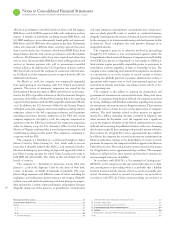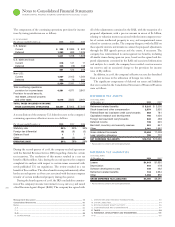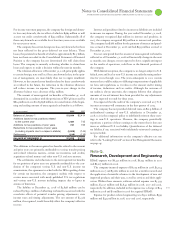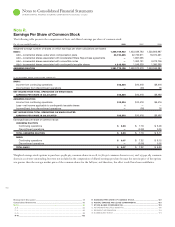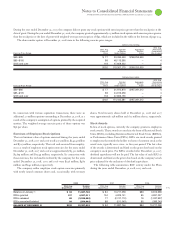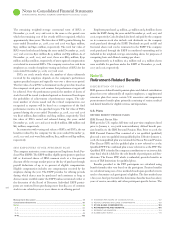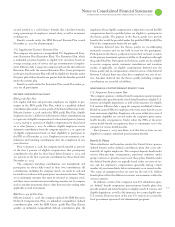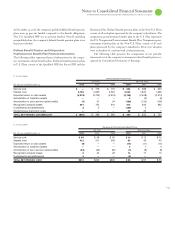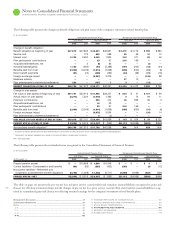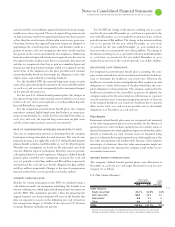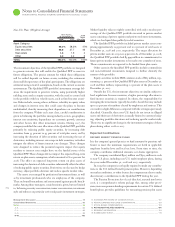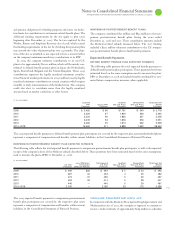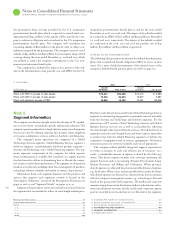IBM 2008 Annual Report Download - page 108
Download and view the complete annual report
Please find page 108 of the 2008 IBM annual report below. You can navigate through the pages in the report by either clicking on the pages listed below, or by using the keyword search tool below to find specific information within the annual report.
Notes to Consolidated Financial Statements
INTERNATIONAL BUSINESS MACHINES CORPORATION and Subsidiary Companies
Management Discussion ............................................................................................. 18
Consolidated Statements ............................................................................................ 60
Notes ............................................................................................................................... 66
A – E ........................................................................................................................66
F – J ........................................................................................................................86
K– Q .......................................................................................................................88
R –W ..................................................................................................................... 102
R. EARNINGS PER SHARE OF COMMON STOCK .............................................. 102
S. RENTAL EXPENSE AND LEASE COMMITMENTS ........................................... 103
T. STOCK-BASED COMPENSATION .................................................................. 103
U. RETIREMENT-RELATED BENEFITS ............................................................... 10 6
V. SEGMENT INFORMATION .............................................................................. 116
W. SUBSEQUENT EVENT .................................................................................... 119
The remaining weighted-average contractual term of RSUs at
December , , and is the same as the period over
which the remaining cost of the awards will be recognized, which is
approximately three years. The fair value of RSUs granted during the
years ended December , , and was $ million,
$ million and $ million, respectively. The total fair value of
RSUs vested and released during the years ended December , ,
and was $ million, $ million and $ million. As of
December , , and , there was $ million, $
million and $ million, respectively, of unrecognized compensation
cost related to nonvested RSUs. The company received no cash from
employees as a result of employee vesting and release of RSUs for the
years ended December , , and .
PSUs are stock awards where the number of shares ultimately
received by the employee depends on the company’s performance
against specified targets and typically vest over a three-year period.
The fair value of each PSU is determined on the grant date, based on
the company’s stock price, and assumes that performance targets will
be achieved. Over the performance period, the number of shares of
stock that will be issued is adjusted upward or downward based upon
the probability of achievement of performance targets. The ulti-
mate number of shares issued and the related compensation cost
recognized as expense will be based on a comparison of the final
performance metrics to the specified targets. The fair value of PSUs
granted during the years ended December , , and
was $ million, $ million and $ million, respectively. Total
fair value of PSUs vested and released during the years ended
December , , and was $ million, $ million and
$ million, respectively.
In connection with vesting and release of RSUs and PSUs, the tax
benefits realized by the company for the years ended December ,
, and were $ million, $ million and $ million,
respectively.
The company maintains a non-compensatory Employees Stock Pur-
chase Plan (ESPP). The ESPP enables eligible participants to purchase
full or fractional shares of IBM common stock at a five-percent
discount off the average market price on the day of purchase through
payroll deductions of up to percent of eligible compensation.
Eligible compensation includes any compensation received by the
employee during the year. The ESPP provides for offering periods
during which shares may be purchased and continues as long as
shares remain available under the ESPP, unless terminated earlier at
the discretion of the Board of Directors. Individual ESPP partici-
pants are restricted from purchasing more than $, of common
stock in one calendar year or , shares in an offering period.
Employees purchased . million, . million and . million shares
under the ESPP during the years ended December , , and
, respectively. Cash dividends declared and paid by the company
on its common stock also include cash dividends on the company
stock purchased through the ESPP. Dividends are paid on full and
fractional shares and can be reinvested in the ESPP. The company
stock purchased through the ESPP is considered outstanding and is
included in the weighted-average outstanding shares for purposes of
computing basic and diluted earnings per share.
Approximately . million, . million and . million shares
were available for purchase under the ESPP at December , ,
and , respectively.
Note U.
Retirement-Related Benefits
IBM sponsors defined benefit pension plans and defined contribution
plans that cover substantially all regular employees, a supplemental
retention plan that covers certain U.S. executives and nonpension
postretirement benefit plans primarily consisting of retiree medical
and dental benefits for eligible retirees and dependents.
U.S. Plans
DEFINED BENEFIT PENSION PLANS
IBM Personal Pension Plan
IBM provides U.S. regular, full-time and part-time employees hired
prior to January , with noncontributory defined benefit pen-
sion benefits via the IBM Personal Pension Plan. Prior to , the
IBM Personal Pension Plan consisted of a tax qualified (qualified)
plan and a non-tax qualified (nonqualified) plan. Effective January ,
, the nonqualified plan was renamed the Excess Personal Pension
Plan (Excess PPP) and the qualified plan is now referred to as the
Qualified PPP. The combined plan is now referred to as the PPP. The
Qualified PPP is funded by company contributions to an irrevocable
trust fund, which is held for the sole benefit of participants and ben-
eficiaries. The Excess PPP, which is unfunded, provides benefits in
excess of IRS limitations for qualified plans.
Benefits provided to the PPP participants are calculated using
benefit formulas that vary based on the participant. Pension benefits
are calculated using one of two methods based upon specified criteria
used to determine each participant’s eligibility. The first method uses
a five-year, final pay formula that determines benefits based on salary,
years of service, mortality and other participant-specific factors. The




